Tunable Stiffness and Damping Study on Flexible PVC Cantilever Structure Embedded with MR Fluid
Abstract
:1. Introduction
2. Characterization of MR Fluid
3. Development of Flexible PVC Structure with MR Fluid
4. Measurement of Magnetic Field Intensity
5. Experimentation
5.1. Vibration Response of the Cantilever Structure
5.2. Stiffness Characterization of the Cantilever Structure
6. Results and Discussion
6.1. Damping Properties
6.2. Stiffness Variation
7. Conclusions
Author Contributions
Funding
Data Availability Statement
Acknowledgments
Conflicts of Interest
References
- Symans, M.D.; Constantinou, M.C. Semi-active control systems for seismic protection of structures: A state-of-the-art review. Eng. Struct. 1999, 21, 469–487. [Google Scholar] [CrossRef]
- Kandasamy, R.; Cui, F.; Townsend, N.; Foo, C.C.; Guo, J.; Shenoi, A.; Xiong, Y. A review of vibration control methods for marine offshore structures. Ocean Eng. 2016, 127, 279–297. [Google Scholar] [CrossRef]
- Soong, T.T.; Spencer, B.F. Active, semi-active and hybrid control of structures. Bull. N. Z. Natl. Soc. Earthqu. Eng. 2000, 33, 387–402. [Google Scholar] [CrossRef] [Green Version]
- Pinkos, A.; Shtarkman, E.; Fitzgerald, T. An Actively Damped Passenger Car Suspension System with Low Voltage Electro Rheological Magnetic Fluid. In Proceedings of the North American Conference on Smart Structures and Materials, Orlando, FL, USA, 13–18 February 1994; pp. 28–35. [Google Scholar]
- Choi, S.-B.; Park, Y.-K.; Jung, S.-B. Modal Characteristics of a Flexible Smart Plate Filled with Electrorheological Fluids. J. Aircr. 1999, 36, 458–464. [Google Scholar] [CrossRef]
- Yeh, J.-Y. Free vibration analysis of rotating polar orthotropic annular plate with ER damping treatment. Compos. Part B Eng. 2011, 42, 781–788. [Google Scholar] [CrossRef]
- Haiqing, G.; King, L.M.; Cher, T.B. Influence of a Locally Applied Electro-Rheological Fluid Layer on Vibration of a Simple Cantilever Beam. J. Intell. Mater. Syst. Struct. 1993, 4, 379–384. [Google Scholar] [CrossRef]
- Sun, Q.; Zhou, J.-X.; Zhang, L. An adaptive beam model and dynamic characteristics of magneto rheological materials. J. Sound Vib. 2003, 261, 465–481. [Google Scholar] [CrossRef]
- Rajamohan, V.; Sundararaman, V.; Govindarajan, B. Finite Element Vibration Analysis of a Magnetorheological Fluid Sandwich Beam. Procedia Eng. 2013, 64, 603–612. [Google Scholar] [CrossRef] [Green Version]
- Wei, M.; Sun, L.; Hu, G. Dynamic properties of an axially moving sandwich beam with magnetorheological fluid core. Adv. Mech. Eng. 2017, 9, 1687814017693182. [Google Scholar] [CrossRef] [Green Version]
- Carlson, J.D.; Jolly, M.R. MR fluid, foam and elastomer devices. Mechatronics 2000, 10, 555–569. [Google Scholar] [CrossRef]
- Wang, J.; Meng, G. Magnetorheological fluid devices: Principles, characteristics and applications in mechanical engineering. Proc. Inst. Mech. Eng. Part L J. Mater. Des. Appl. 2001, 215, 165–174. [Google Scholar] [CrossRef]
- Eshaghi, M.; Sedaghati, R.; Rakheja, S. Dynamic characteristics and control of magnetorheological/ electrorheological sandwich structures: A state-of-the-art review. J. Intell. Mater. Syst. Struct. 2016, 27, 2003–2037. [Google Scholar] [CrossRef]
- Kolekar, S.; Venkatesh, K.; Oh, J.S.; Choi, S.B. Vibration controllability of sandwich structures with smart materials of electrorheological fluids and magnetorheological materials: A review. J. Vib. Eng. Technol. 2019, 7, 359–377. [Google Scholar] [CrossRef]
- Yalcintas, M.; Dai, H. Vibration suppression capabilities of magneto-rheological materials based adaptive structures. Smart Mater. Struct. 2004, 13, 1–11. [Google Scholar] [CrossRef]
- Chen, L.; Hansen, C.H. Active vibration control of magneto rheological sandwich beam. In Proceedings of the Acoustics, Buellton, WA, Australia, 9–15 November 2005. [Google Scholar]
- Yeh, Z.F.; Shih, Y.S. Dynamic characteristics and dynamic instability of magnetorheological material-based adaptive beams. J Compos. Mater. 2006, 40, 1333–1359. [Google Scholar] [CrossRef]
- Rajamohan, V.; Sedaghati, R.; Rakheja, S. Vibration analysis of a multi-layer beam containing magnetorheological fluid. Smart Mater. Struct. 2010, 19, 015013. [Google Scholar] [CrossRef]
- Romaszko, M.; Pakula, S.; Sapinski, B. Vibration parameters of a sandwich beams with two types of MR fluid. Int. J. Mech. Control 2011, 30, 151–156. [Google Scholar]
- Eshaghi, M.; Sedaghati, R.; Rakheja, S. The effect of magneto-rheological fluid on vibration suppression capability of adaptive sandwich plates: Experimental and finite element analysis. J. Intell. Mater. Syst. Struct. 2015, 26, 1920–1935. [Google Scholar] [CrossRef]
- Eshaghi, M.; Sedaghati, R.; Rakheja, S. Analytical and experimental free vibration analysis of multi-layer MR-fluid circular plates under varying magnetic flux. Compos. Struct. 2016, 157, 78–86. [Google Scholar] [CrossRef]
- Lara-Prieto, V.; Parkin, R.; Jackson, M. Vibration characteristics of MR cantilever sandwich beams: Experimental study. Smart Mater. Struct. 2010, 19, 015005. [Google Scholar] [CrossRef] [Green Version]
- Snamina, J. Facility for investigating the vibration of the plate with magneto rheological fluid. Mech. Control 2012, 31, 85–89. [Google Scholar] [CrossRef] [Green Version]
- Manoharan, R.; Vasudevan, R.; Sudhagar, P.E. Semi-active vibration control of laminated composite sandwich—An experimental study. Arch. Mech. Eng. 2016, LXIII, 367–377. [Google Scholar] [CrossRef] [Green Version]
- Arumugam, A.B.; Ramamoorthy, M.; Rajamohan, V. Dynamic characterization and parametric instability analysis of rotating magnetorheological fluid composite sandwich plate subjected to periodic in-plane loading. J. Sandw. Struct. Mater. 2018, 21, 2099–2126. [Google Scholar] [CrossRef]



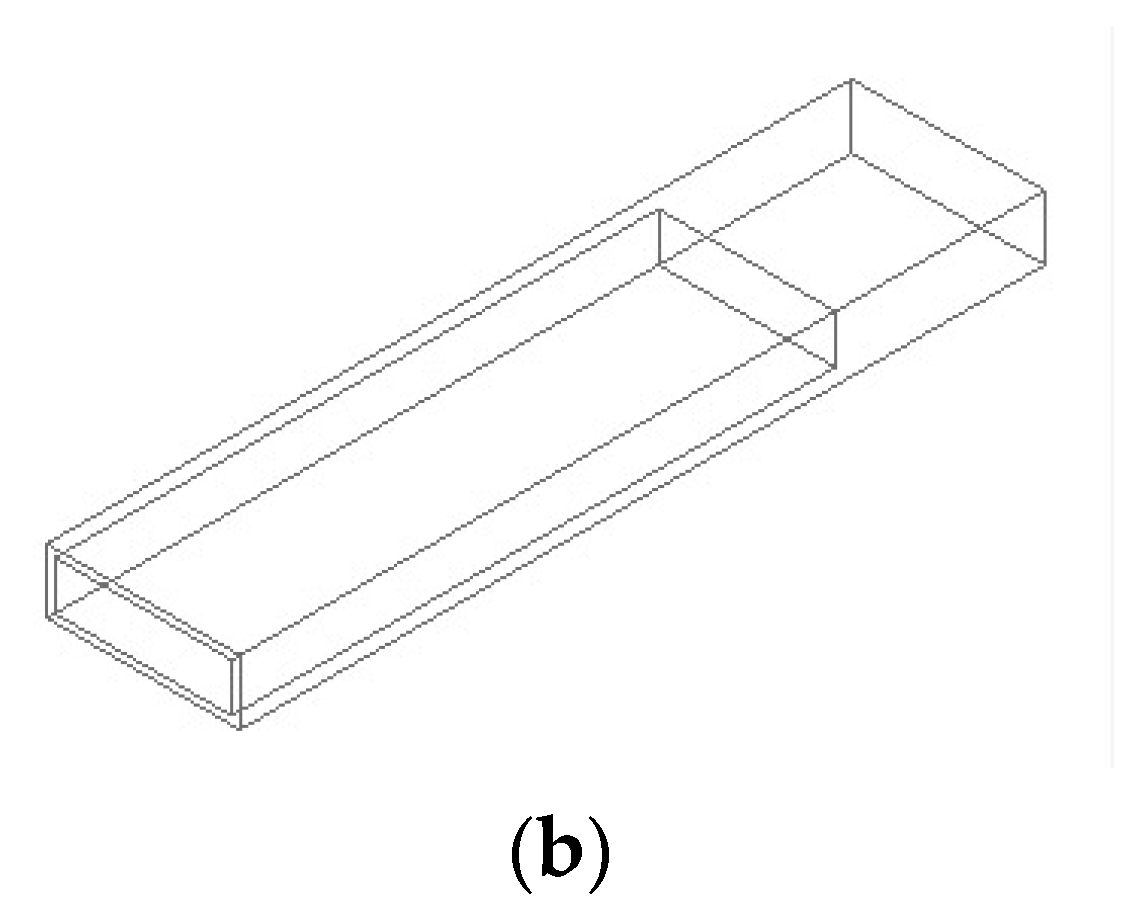
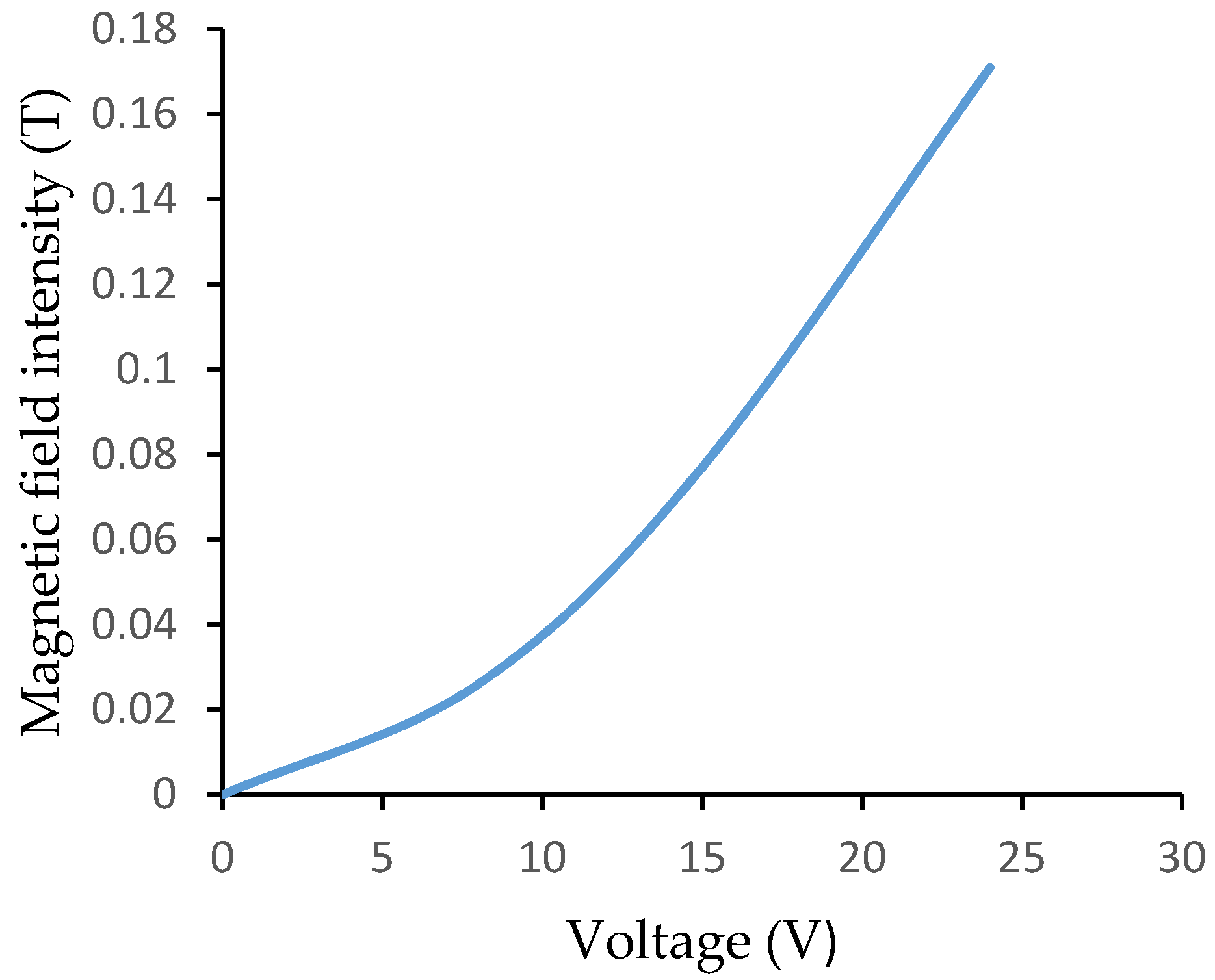
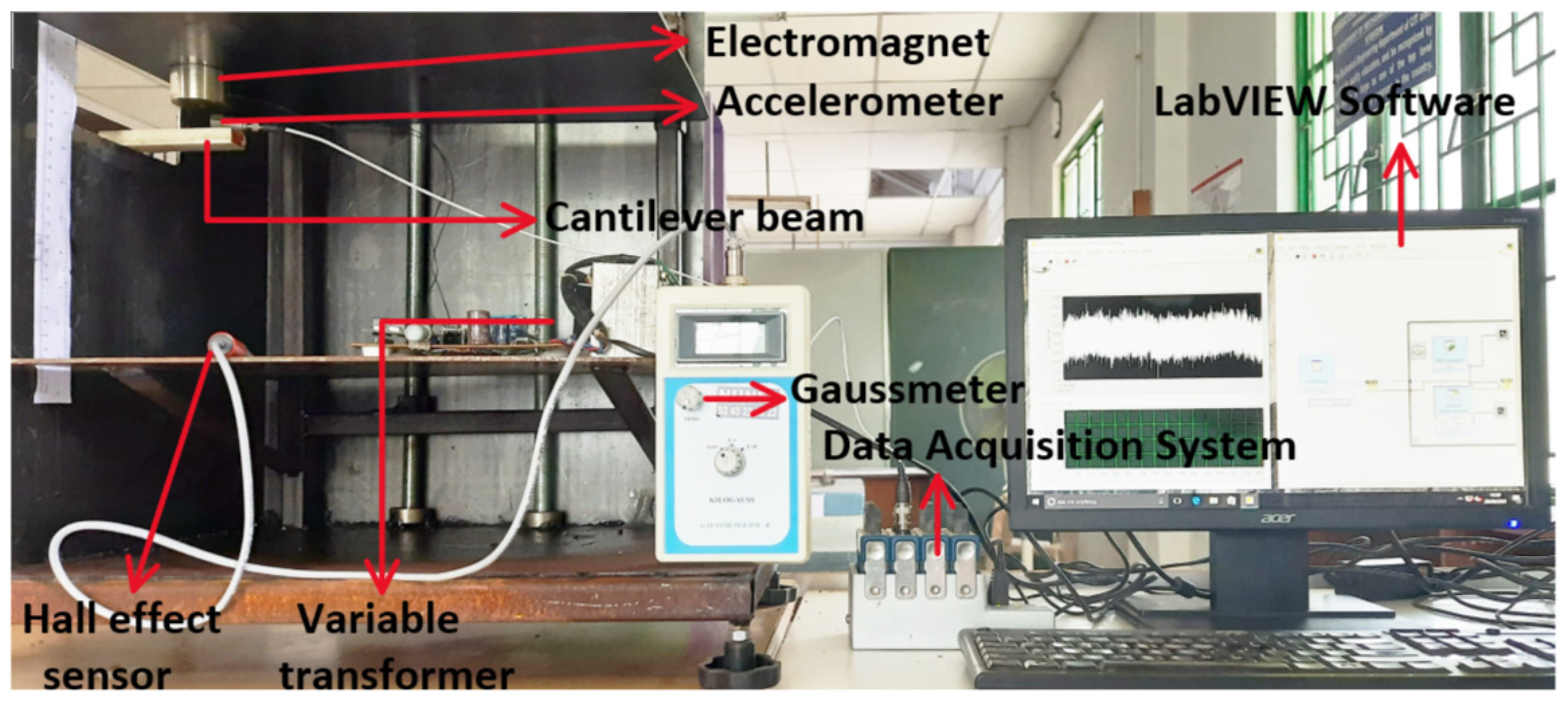
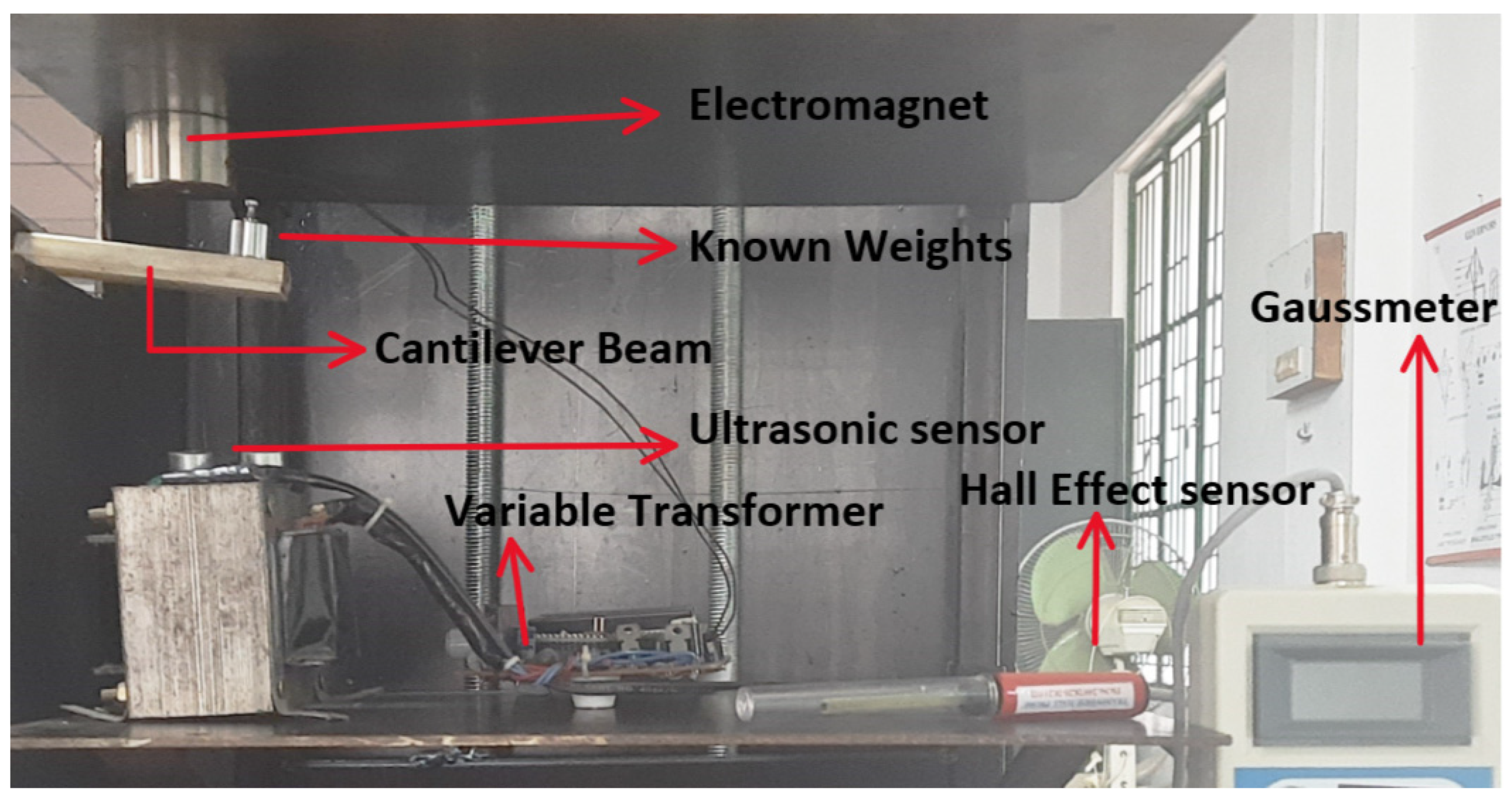
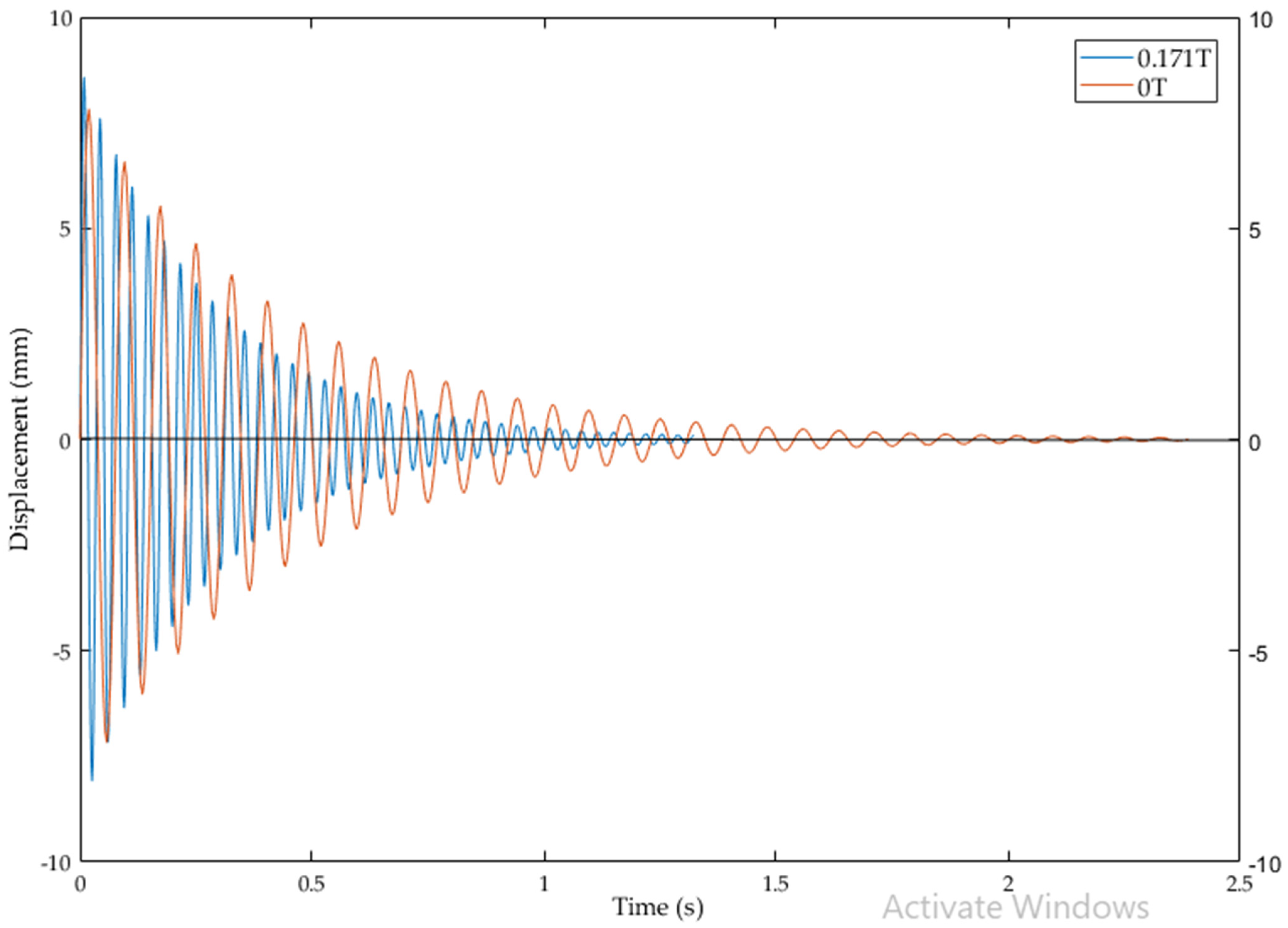

| Physical Properties | MR Fluid |
|---|---|
| Density (g/mL) | 2.45 |
| Viscosity (Pa·s) | 0.29 |
| Type of Cantilever Structure | Damping Ratio | Logarithmic Decrement | Natural Frequency (Hz) |
|---|---|---|---|
| With MR Fluid at 0 V (0 T) | 0.0191 | 0.12 | 13.91 |
| With MR Fluid at 24 V (0.171 T) | 0.0276 | 0.174 | 29.24 |
| Magnetic Flux Density | Curve Fitting for Non-Linear Function | R2 |
|---|---|---|
| 0.026 T | y = 0.000042x3 − 0.000084x2 + 0.007975x + 0.000026 | 0.998282 |
| 0.077 T | y = 0.000054x3 + 0.001033x2 + 0.008433x + 0.000249 | 0.999571 |
| 0.171 T | y = 0.002705x3 − 0.012099x2 + 0.044597x − 0.000222 | 0.990199 |
| Magnetic Flux Density | Curve Fitting for Non-Linear Function |
|---|---|
| 0.026 T | k = 0.000126x2 − 0.000168x + 0.00795 |
| 0.077 T | k = 0.000162x2 + 0.0002066x + 0.008433 |
| 0.171 T | k = 0.008115x2 − 0.024198x + 0.044597 |
Publisher’s Note: MDPI stays neutral with regard to jurisdictional claims in published maps and institutional affiliations. |
© 2021 by the authors. Licensee MDPI, Basel, Switzerland. This article is an open access article distributed under the terms and conditions of the Creative Commons Attribution (CC BY) license (https://creativecommons.org/licenses/by/4.0/).
Share and Cite
Ramkumar, G.; Gnanaprakasam, A.J.; Thirumarimurugan, M. Tunable Stiffness and Damping Study on Flexible PVC Cantilever Structure Embedded with MR Fluid. Materials 2021, 14, 5024. https://doi.org/10.3390/ma14175024
Ramkumar G, Gnanaprakasam AJ, Thirumarimurugan M. Tunable Stiffness and Damping Study on Flexible PVC Cantilever Structure Embedded with MR Fluid. Materials. 2021; 14(17):5024. https://doi.org/10.3390/ma14175024
Chicago/Turabian StyleRamkumar, Gunasekaran, Arul Jesu Gnanaprakasam, and Marimuthu Thirumarimurugan. 2021. "Tunable Stiffness and Damping Study on Flexible PVC Cantilever Structure Embedded with MR Fluid" Materials 14, no. 17: 5024. https://doi.org/10.3390/ma14175024





